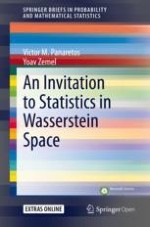This open access book presents the key aspects of statistics in Wasserstein spaces, i.e. statistics in the space of probability measures when endowed with the geometry of optimal transportation. Further to reviewing state-of-the-art aspects, it also provides an accessible introduction to the fundamentals of this current topic, as well as an overview that will serve as an invitation and catalyst for further research.
Statistics in Wasserstein spaces represents an emerging topic in mathematical statistics, situated at the interface between functional data analysis (where the data are functions, thus lying in infinite dimensional Hilbert space) and non-Euclidean statistics (where the data satisfy nonlinear constraints, thus lying on non-Euclidean manifolds). The Wasserstein space provides the natural mathematical formalism to describe data collections that are best modeled as random measures on Euclidean space (e.g. images and point processes). Such random measures carry the infinite dimensional traits of functional data, but are intrinsically nonlinear due to positivity and integrability restrictions. Indeed, their dominating statistical variation arises through random deformations of an underlying template, a theme that is pursued in depth in this monograph.
